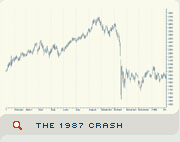


A Shock that Fueled the Continuation of the Bull Market
As was the crash in 1929, the stock market collapse
in October 1987 was preceded by a bull market that would not die. In 1987,
the bull run had lasted five years, during which time the Dow Jones average
had more than tripled. In the first eight months of 1987, as the
bull made its final surge, the Dow Jones average had gone from under 2000
to over 2700. Many investors spoke of a "new era".
However, there were some doomsayers observing mounting parallels between
the crash in 1929.
In January, and again in October of 1987, The Atlantic Monthly magazine
ran articles that virtually predicted a market collapse. Elaine
Garzarelli, then an analyst for Shearson Lehman Brothers, whose claim
of fame emerged from her call on the market crash, repeatedly warned of
an impending collapse and received enough air time to make investors nervous.
Other bears were vocal as well although, as with Garzarelli, the attention
they received after the crash may in retrospect overstate the following
they had before the fall of 1987. Among those calling for a collapse were
James Grant, of Grant's Interest Rate Observer, Alan Greene, a prominent
Wall Street money manager, and Jim Rogers, now a globe trotter with occasional
appearances on the financial networks.
The bears argued that the combination of rich valuation levels and frothy market conditions made a severe correction inevitable. Clearly, valuation levels appeared stretched. Stock prices were running at twenty-three times earnings, far higher than what is considered healthy. A historical comparison of P/E ratios reflected that the market was as overvalued as in the late 20ies and the late 60ies.
Another cause of concern was the gold rush mentality that had embraced individual investors. The craze for mutual funds caused them to stop advertising. However, Fidelity could no longer tame the monster it had created. Money kept pouring in. A combination of attractive returns and aggressive marketing by the mutual fund companies had led to a bonanza. Fund Managers like Peter Lynch of the Fidelity Magellan Fund had developed into icons.
The Dow Jones Industrials Index peaked on August 24, 1987 and an abrupt sell-off followed. However, the optimism did not vanish all at once and a rally carried the Dow back up into early October. The bull market took its last breath on Tuesday, October 13, when the Dow Jones average rose thirty-seven points. From there on the bears were put firmly into the driver's seat. On Wednesday, the market dropped ninety-five points. On Thursday, it dropped another fifty-seven points. And on Friday, October 16, the market virtually gave out, losing 108 points--almost 5 percent of its value--as a record 338 million shares were traded.
Hectic attempts by professional portfolio managers and investors to assess the situation were on their way all weekend. Since many mutual funds were carrying little cash and saw hefty redemptions in the previous days it was a for drawn conclusion that these funds had to sell positions in order to meet redemptions. At all the mutual fund companies and brokerage houses the phone lines were jammed; Fidelity alone received 80,000 calls from customers that weekend following Friday's 108 point drop. Investors were panicking and bailed out, many placing market orders. Obviously, the orders could not be filled, however, the order flow left little doubt about what would happen in the market on Monday. Rumors emerged that Fidelity alone had to dump 1 billion worth of stocks on Monday morning.
The head o the New York stocks Exchange expected a steep
decline as did other well respected sources including Robert Farrell.
Inevitably, on Monday the Dow opened down sharply and fell some 300 points,
but stabilized in the early afternoon. Then, in the last hour of trading
bids disappeared and the Dow fell about 200 points. At the end of
the day the Dow Jones average closed at 1738 – a 508 point collapse.
That amounted to a staggering 22 percent loss, the largest one-day drop
ever. Hectic activity was replaced by silence on the floor and in brokerage
houses. People seemed to realize that words were inadequate to describe
what they had just been through. There was simply nothing left to say
or do.
The following Tuesday was as scary a day Black Monday. The Dow first shot up by 200 points then reversed to 150 points down. Finally as all sell orders wee filled, the market recovered into positive territory.
The role of portfolio insurance programs was hotly debated ever after the crash, and the blame of the crash was conveniently put on the computers. Later on several studies concluded that portfolio insurance accounted to approximately 15 percent of selling on Black Monday. Clearly, program trading added to the panic and accelerated the selling, but was only one of the reasons that led to the collapse.
As shocking as the October 1982 experience was, the fear of lower prices persisted for at least another 10 years and this "Wall of Worry" helped to keep the froth out of the market until at least 1996.

The 1987 Crash shocked Wall Street but did not stop the bull market that started in 1982. The Dow Jones finished the year of 1987 actually with a gain.
|
|
|